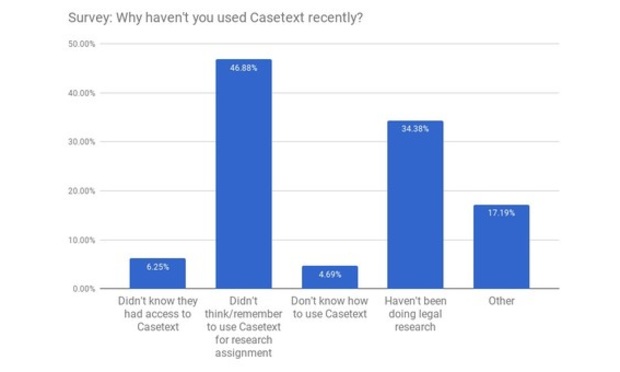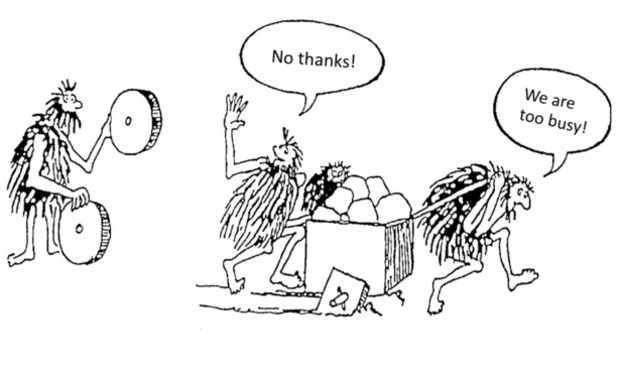The Most Important Word in Legal Tech: Engagement
Six ways to get innovation not just bought by firms, but actually used by attorneys.
May 09, 2018 at 08:00 AM
6 minute read

There is a widespread belief among legal technology entrepreneurs that if you build a great and innovative product—and go through the what feels like the impossibly long and complex task of selling it to law firms—then you've achieved success. I'll cop to it: at the start of Casetext, I was of this mindset. Oh, how young! How naive!
I want to use this column to impart to fellow legal tech entrepreneurs, as well as attorneys and law firm staff interested in using technology to better their firm's practice, a bit of wisdom earned the hard way: Getting attorneys to use even great technology is really hard work, but there are ways to get there if you make it your central focus.
A lot of what follows comes from our experience at Casetext working with firms like O'Melveny & Myers, Ogletree Deakins, DLA Piper and dozens more, big and small, that subscribe to our services. Some of this was also derived from a panel conversation with some of the leaders from those firms at Stanford Law's CodeX Future Law Conference in April.
Before we dive into solutions, let's start with why getting attorneys to use technology is hard.
First, getting anybody to adopt anything new is hard. As D. Casey Flaherty has noted in a post about innovation in law, previous “innovations” outside of law that faced difficulty with adoption include boiling water to avoid typhoid, surgeons washing their hands before surgery and basketball teams shooting three-pointers even though they're statistically more likely to win games if they shot more.
There are particular challenges in getting technology adopted by lawyers. Large firms in particular can have multiple offices where word doesn't spread as quickly; we've hosted trainings at some offices where nobody was even aware they had access to the technology before we came! Also, most attorneys still bill by the hour, and learning new technology isn't billable.
Lawyers are busy people handling a dozen things at once. The chance that they'll simply forget about the product after a training is high. We conducted a survey of firm attorneys who had learned about our product but hadn't used it in a while, and over 50 percent of the respondents either forgot they had access to Casetext, didn't think to use it or don't know how to use it:

Some lawyers are so busy that the idea of spending even 15 minutes at a training to learn a new technology is overwhelming—those folks remind me of this cartoon:

So what can you do about it? The panelists from the CodeX event—firm leaders from Greenberg Traurig, O'Melveny & Myers, DLA Piper and Ogletree Deakins—offered some great advice:
It's a marketing challenge: The rule of thumb in marketing is that someone needs seven touches—seven interactions with your brand and product—before they engage with it meaningfully. The same is true of every lawyer in a firm. Firm leaders have gotten creative about how to do this: When rolling out a product, they might give everyone a physical tchotchke that sits on every attorney's desk to remind them to use it, have an email come from the managing partner, or put up posters throughout the firm.
Someone within the firm has to push the product: If there isn't support from within the firm—or worse, if the firm is affirmatively locking down communications to attorneys about the product—then it's really hard, if not impossible, to reach your seven touches.
Train, train, train: No matter how easy-to-use your product is (ours is literally drag-and-drop), attorneys often won't have the time to put into learning a new tool and will avoid even giving something a chance if they don't have an idea of how to use it. Get on campus and offer lunch, do remote trainings, whatever it takes.
Make engagement into a game: Something that's been successful for us at the firms with which we've worked is making participating in your product fun and a game. Pair offices against each other: The one that uses your product more that week wins a prize. Lawyers are often competitive, sometimes bored (even when they're busy), so making it a little fun and competitive goes a long way towards getting them to actually engage with your product.
Use technology to make the product more engaging: Not all products can do this, but if you have a good reason to reach out to attorneys to re-engage them with the product, do it! In our case, Casetext's CARA Notifications technology reads all briefs a firm is litigating from public dockets, and when opposing counsel files something, it instantly emails firm attorneys with its analysis of opposing counsel's brief, including the best cases to cite in opposition. It's independently useful, but also a great opportunity to re-engage. (Never do this if you don't have something good to send folks—that backfires big time.)
Hire great people to focus on engagement: We are lucky to have at the helm of our push for engagement Amanda Gudis, a former KM attorney who led the roll-out of Casetext while at Ogletree. She knows her stuff, works her butt off, and is genuinely wonderful to work with (in fact, she got two spontaneous shout-outs by our clients on the panel). Find your Amanda Gudis (but not literally Amanda, she's taken!) and they will go a long way towards making engagement a success.
So if you go around thinking, like in Field of Dreams, “If you build it, they will come,” snap out of it. That's for baseball movies, not legal tech. But fear not, there are concrete ways to get there: commit to engagement, hire for it, be creative and treat it as a top priority, and you'll overcome otherwise herculean challenges for getting technology adopted.
Jake Heller is the co-founder and CEO of Casetext. Before starting Casetext, Jake was a litigator at Ropes & Gray. He's a Silicon Valley native, and has been programming since childhood. For more information about Casetext's CARA A.I., visit info.casetext.com/cara-ai.
This content has been archived. It is available through our partners, LexisNexis® and Bloomberg Law.
To view this content, please continue to their sites.
Not a Lexis Subscriber?
Subscribe Now
Not a Bloomberg Law Subscriber?
Subscribe Now
NOT FOR REPRINT
© 2025 ALM Global, LLC, All Rights Reserved. Request academic re-use from www.copyright.com. All other uses, submit a request to [email protected]. For more information visit Asset & Logo Licensing.
You Might Like
View AllTrending Stories
- 1Uber Files RICO Suit Against Plaintiff-Side Firms Alleging Fraudulent Injury Claims
- 2The Law Firm Disrupted: Scrutinizing the Elephant More Than the Mouse
- 3Inherent Diminished Value Damages Unavailable to 3rd-Party Claimants, Court Says
- 4Pa. Defense Firm Sued by Client Over Ex-Eagles Player's $43.5M Med Mal Win
- 5Losses Mount at Morris Manning, but Departing Ex-Chair Stays Bullish About His Old Firm's Future
Who Got The Work
J. Brugh Lower of Gibbons has entered an appearance for industrial equipment supplier Devco Corporation in a pending trademark infringement lawsuit. The suit, accusing the defendant of selling knock-off Graco products, was filed Dec. 18 in New Jersey District Court by Rivkin Radler on behalf of Graco Inc. and Graco Minnesota. The case, assigned to U.S. District Judge Zahid N. Quraishi, is 3:24-cv-11294, Graco Inc. et al v. Devco Corporation.
Who Got The Work
Rebecca Maller-Stein and Kent A. Yalowitz of Arnold & Porter Kaye Scholer have entered their appearances for Hanaco Venture Capital and its executives, Lior Prosor and David Frankel, in a pending securities lawsuit. The action, filed on Dec. 24 in New York Southern District Court by Zell, Aron & Co. on behalf of Goldeneye Advisors, accuses the defendants of negligently and fraudulently managing the plaintiff's $1 million investment. The case, assigned to U.S. District Judge Vernon S. Broderick, is 1:24-cv-09918, Goldeneye Advisors, LLC v. Hanaco Venture Capital, Ltd. et al.
Who Got The Work
Attorneys from A&O Shearman has stepped in as defense counsel for Toronto-Dominion Bank and other defendants in a pending securities class action. The suit, filed Dec. 11 in New York Southern District Court by Bleichmar Fonti & Auld, accuses the defendants of concealing the bank's 'pervasive' deficiencies in regards to its compliance with the Bank Secrecy Act and the quality of its anti-money laundering controls. The case, assigned to U.S. District Judge Arun Subramanian, is 1:24-cv-09445, Gonzalez v. The Toronto-Dominion Bank et al.
Who Got The Work
Crown Castle International, a Pennsylvania company providing shared communications infrastructure, has turned to Luke D. Wolf of Gordon Rees Scully Mansukhani to fend off a pending breach-of-contract lawsuit. The court action, filed Nov. 25 in Michigan Eastern District Court by Hooper Hathaway PC on behalf of The Town Residences LLC, accuses Crown Castle of failing to transfer approximately $30,000 in utility payments from T-Mobile in breach of a roof-top lease and assignment agreement. The case, assigned to U.S. District Judge Susan K. Declercq, is 2:24-cv-13131, The Town Residences LLC v. T-Mobile US, Inc. et al.
Who Got The Work
Wilfred P. Coronato and Daniel M. Schwartz of McCarter & English have stepped in as defense counsel to Electrolux Home Products Inc. in a pending product liability lawsuit. The court action, filed Nov. 26 in New York Eastern District Court by Poulos Lopiccolo PC and Nagel Rice LLP on behalf of David Stern, alleges that the defendant's refrigerators’ drawers and shelving repeatedly break and fall apart within months after purchase. The case, assigned to U.S. District Judge Joan M. Azrack, is 2:24-cv-08204, Stern v. Electrolux Home Products, Inc.
Featured Firms
Law Offices of Gary Martin Hays & Associates, P.C.
(470) 294-1674
Law Offices of Mark E. Salomone
(857) 444-6468
Smith & Hassler
(713) 739-1250






